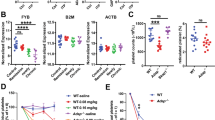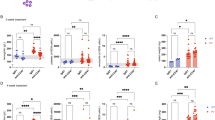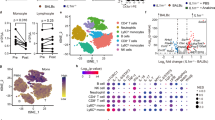Abstract
Primary immune thrombocytopenia (ITP) is an autoimmune hemorrhagic disorder in which macrophages play a critical role. Mammalian sterile-20-like kinase 4 (MST4), a member of the germinal-center kinase STE20 family, has been demonstrated to be a regulator of inflammation. Whether MST4 participates in the macrophage-dependent inflammation of ITP remains elusive. The expression and function of MST4 in macrophages of ITP patients and THP-1 cells, and of a macrophage-specific Mst4−/− (Mst4ΔM/ΔM) ITP mouse model were determined. Macrophage phagocytic assays, RNA sequencing (RNA-seq) analysis, immunofluorescence analysis, coimmunoprecipitation (co-IP), mass spectrometry (MS), bioinformatics analysis, and phosphoproteomics analysis were performed to reveal the underlying mechanisms. The expression levels of the MST4 gene were elevated in the expanded M1-like macrophages of ITP patients, and this elevated expression of MST4 was restored to basal levels in patients with remission after high-dose dexamethasone treatment. The expression of the MST4 gene was significantly elevated in THP-1-derived M1 macrophages. Silencing of MST4 decreased the expression of M1 macrophage markers and cytokines, and impaired phagocytosis, which could be increased by overexpression of MST4. In a passive ITP mouse model, macrophage-specific depletion of Mst4 reduced the numbers of M1 macrophages in the spleen and peritoneal lavage fluid, attenuated the expression of M1 cytokines, and promoted the predominance of FcγRIIb in splenic macrophages, which resulted in amelioration of thrombocytopenia. Downregulation of MST4 directly inhibited STAT1 phosphorylation, which is essential for M1 polarization of macrophages. Our study elucidates a critical role for MST4 kinase in the pathology of ITP and identifies MST4 kinase as a potential therapeutic target for refractory ITP.
This is a preview of subscription content, access via your institution
Access options
Subscribe to this journal
Receive 12 digital issues and online access to articles
$119.00 per year
only $9.92 per issue
Buy this article
- Purchase on Springer Link
- Instant access to full article PDF
Prices may be subject to local taxes which are calculated during checkout







Similar content being viewed by others
Data availability
All data generated or analyzed in this study are included in this published article [and its supplementary information files.
Change history
31 October 2023
A Correction to this paper has been published: https://doi.org/10.1038/s41423-023-01094-x
References
Cooper N, Ghanima W. Immune thrombocytopenia. N Engl J Med. 2019;381:945–55.
Hou Y, Xie J, Wang S, Li D, Wang L, Wang H, et al. Glucocorticoid receptor modulates myeloid-derived suppressor cell function via mitochondrial metabolism in immune thrombocytopenia. Cell Mol Immunol. 2022;19:764–76.
Zhuang X, Xu P, Ou Y, Shao X, Li Y, Ma Y, et al. Decreased cyclooxygenase-2 associated with impaired megakaryopoiesis and thrombopoiesis in primary immune thrombocytopenia. J Transl Med. 2023;21:540.
Shao X, Xu P, Ji L, Wu B, Zhan Y, Zhuang X, et al. Low-dose decitabine promotes M2 macrophage polarization in patients with primary immune thrombocytopenia via enhancing KLF4 binding to PPARγ promoter. Clin Transl Med. 2023;13:e1344.
Audia S, Mahevas M, Samson M, Godeau B, Bonnotte B. Pathogenesis of immune thrombocytopenia. Autoimmun Rev. 2017;16:620–32.
Bussel J, Cooper N, Boccia R, Zaja F, Newland A. Immune thrombocytopenia. Expert Rev Hematol. 2021;14:1013–25.
Semple JW, Rebetz J, Maouia A, Kapur R. An update on the pathophysiology of immune thrombocytopenia. Curr Opin Hematol. 2020;27:423–9.
Neunert C, Terrell DR, Arnold DM, Buchanan G, Cines DB, Cooper N, et al. American Society of Hematology 2019 guidelines for immune thrombocytopenia. Blood Adv. 2019;3:3829–66.
Ou Y, Zhan Y, Zhuang X, Shao X, Xu P, Li F, et al. A bibliometric analysis of primary immune thrombocytopenia from 2011 to 2021. Neutrophils contribute to elevated BAFF levels to modulate adaptive immunity in patients with primary immune thrombocytopenia by CD62P and PSGL1 interaction. Br J Haematol. 2023;201:954–70.
Zhan Y, Cao J, Ji L, Zhang M, Shen Q, Xu P, et al. Impaired mitochondria of Tregs decreases OXPHOS-derived ATP in primary immune thrombocytopenia with positive plasma pathogens detected by metagenomic sequencing. Exp Hematol Oncol. 2022;11:48.
Nahrendorf M, Swirski FK. Monocyte and macrophage heterogeneity in the heart. Circ Res. 2013;112:1624–33.
Hashimoto D, Miller J, Merad M. Dendritic cell and macrophage heterogeneity in vivo. Immunity. 2011;35:323–35.
Gordon S, Pluddemann A, Martinez Estrada F. Macrophage heterogeneity in tissues: phenotypic diversity and functions. Immunol Rev. 2014;262:36–55.
Cuccarese MF, Dubach JM, Pfirschke C, Engblom C, Garris C, Miller MA, et al. Heterogeneity of macrophage infiltration and therapeutic response in lung carcinoma revealed by 3D organ imaging. Nat Commun. 2017;8:14293.
Udalova IA, Mantovani A, Feldmann M. Macrophage heterogeneity in the context of rheumatoid arthritis. Nat Rev Rheumatol. 2016;12:472–85.
Murray PJ, Wynn TA. Protective and pathogenic functions of macrophage subsets. Nat Rev Immunol. 2011;11:723–37.
Krausgruber T, Blazek K, Smallie T, Alzabin S, Lockstone H, Sahgal N, et al. IRF5 promotes inflammatory macrophage polarization and TH1-TH17 responses. Nat Immunol. 2011;12:231–8.
Feng Q, Xu M, Yu YY, Hou Y, Mi X, Sun YX, et al. High-dose dexamethasone or all-trans-retinoic acid restores the balance of macrophages towards M2 in immune thrombocytopenia. J Thromb Haemost. 2017;15:1845–58.
Di Paola A, Palumbo G, Merli P, Argenziano M, Tortora C, Strocchio L, et al. Effects of eltrombopag on in vitro macrophage polarization in pediatric immune thrombocytopenia. Int J Mol Sci. 2020;22:97.
Psaila B, Bussel JB. Fc receptors in immune thrombocytopenias: a target for immunomodulation? J Clin Investig. 2008;118:2677–81.
Nimmerjahn F, Ravetch JV. Fcgamma receptors as regulators of immune responses. Nat Rev Immunol. 2008;8:34–47.
Wijngaarden S, van de Winkel JG, Jacobs KM, Bijlsma JW, Lafeber FP, van Roon JA. A shift in the balance of inhibitory and activating Fcgamma receptors on monocytes toward the inhibitory Fcgamma receptor IIb is associated with prevention of monocyte activation in rheumatoid arthritis. Arthritis Rheum. 2004;50:3878–87.
Yu X, Lazarus AH. Targeting FcgammaRs to treat antibody-dependent autoimmunity. Autoimmun Rev. 2016;15:510–2.
Liu XG, Ma SH, Sun JZ, Ren J, Shi Y, Sun L, et al. High-dose dexamethasone shifts the balance of stimulatory and inhibitory Fcgamma receptors on monocytes in patients with primary immune thrombocytopenia. Blood. 2011;117:2061–9.
Liu XG, Liu S, Feng Q, Liu XN, Li GS, Sheng Z, et al. Thrombopoietin receptor agonists shift the balance of Fcgamma receptors toward inhibitory receptor IIb on monocytes in ITP. Blood. 2016;128:852–61.
Huang T, Kim CK, Alvarez AA, Pangeni RP, Wan X, Song X, et al. MST4 phosphorylation of ATG4B regulates autophagic activity, tumorigenicity, and radioresistance in glioblastoma. Cancer Cell. 2017;32:840–55.e8.
An L, Nie P, Chen M, Tang Y, Zhang H, Guan J, et al. MST4 kinase suppresses gastric tumorigenesis by limiting YAP activation via a non-canonical pathway. J Exp Med. 2020;217:e20191817.
Shi Z, Jiao S, Zhang Z, Ma M, Zhang Z, Chen C, et al. Structure of the MST4 in complex with MO25 provides insights into its activation mechanism. Structure. 2013;21:449–61.
Ling P, Lu TJ, Yuan CJ, Lai MD. Biosignaling of mammalian Ste20-related kinases. Cell Signal. 2008;20:1237–47.
Jiao S, Zhang Z, Li C, Huang M, Shi Z, Wang Y, et al. The kinase MST4 limits inflammatory responses through direct phosphorylation of the adaptor TRAF6. Nat Immunol. 2015;16:246–57.
Liu X, You J, Peng X, Wang Q, Li C, Jiang N, et al. Mammalian Ste20-like kinase 4 inhibits the inflammatory response in Aspergillus fumigatus keratitis. Int Immunopharmacol. 2020;88:107021.
Luan D, Zhang Y, Yuan L, Chu Z, Ma L, Xu Y, et al. MST4 modulates the neuro-inflammatory response by regulating IkappaBalpha signaling pathway and affects the early outcome of experimental ischemic stroke in mice. Brain Res Bull. 2020;154:43–50.
Provan D, Stasi R, Newland AC, Blanchette VS, Bolton-Maggs P, Bussel JB, et al. International consensus report on the investigation and management of primary immune thrombocytopenia. Blood. 2010;115:168–86.
Shao X, Wu B, Cheng L, Li F, Zhan Y, Liu C, et al. Distinct alterations of CD68(+)CD163(+) M2-like macrophages and myeloid-derived suppressor cells in newly diagnosed primary immune thrombocytopenia with or without CR after high-dose dexamethasone treatment. J Transl Med. 2018;16:48.
Wang J, Xie L, Wang S, Lin J, Liang J, Xu J. Azithromycin promotes alternatively activated macrophage phenotype in systematic lupus erythematosus via PI3K/Akt signaling pathway. Cell Death Dis. 2018;9:1080.
Neschadim A, Branch DR. Mouse Models for Immune-Mediated Platelet Destruction or Immune Thrombocytopenia (ITP). Curr Protoc Immunol. 2016;113:15.30.1–15.30.13.
Han Y, Yu G, Sarioglu H, Caballero-Martinez A, Schlott F, Ueffing M, et al. Proteomic investigation of the interactome of FMNL1 in hematopoietic cells unveils a role in calcium-dependent membrane plasticity. J Proteom. 2013;78:72–82.
Hornbeck PV, Zhang B, Murray B, Kornhauser JM, Latham V, Skrzypek E. PhosphoSitePlus, 2014: mutations, PTMs and recalibrations. Nucleic Acids Res. 2015;43:D512–20.
Lawrence T, Natoli G. Transcriptional regulation of macrophage polarization: enabling diversity with identity. Nat Rev Immunol. 2011;11:750–61.
Grace RF, Lambert MP. An update on pediatric immune thrombocytopenia (ITP): differentiating primary ITP, IPD, and PID. Blood. 2021.
Palandri F, Rossi E, Bartoletti D, Ferretti A, Ruggeri M, Lucchini E, et al. Real-world use of thrombopoietin receptor agonists in older patients with primary immune thrombocytopenia. Blood. 2021;138:571–83.
Bolton-Maggs PHB, George JN. Immune thrombocytopenia treatment. N Engl J Med. 2021;385:948–50.
Lambert MP, Gernsheimer TB. Clinical updates in adult immune thrombocytopenia. Blood. 2017;129:2829–35.
Wang H, Yu T, An N, Sun Y, Xu P, Han P, et al. Enhancing regulatory T-cell function via inhibition of high mobility group box 1 protein signaling in immune thrombocytopenia. Haematologica. 2023;108:843–58.
Ni X, Wang L, Wang H, Yu T, Xie J, Li G, et al. Low-dose decitabine modulates myeloid-derived suppressor cell fitness via LKB1 in immune thrombocytopenia. Blood. 2022;140:2818–34.
Ehrchen JM, Roth J, Barczyk-Kahlert K. More than suppression: glucocorticoid action on monocytes and macrophages. Front Immunol. 2019;10:2028.
Cain DW, Cidlowski JA. Immune regulation by glucocorticoids. Nat Rev Immunol. 2017;17:233–47.
Caputo M, Cansby E, Kumari S, Kurhe Y, Nair S, Stahlman M, et al. STE20-type protein kinase MST4 controls NAFLD progression by regulating lipid droplet dynamics and metabolic stress in hepatocytes. Hepatol Commun. 2021;5:1183–200.
Ramsauer K, Sadzak I, Porras A, Pilz A, Nebreda AR, Decker T, et al. p38 MAPK enhances STAT1-dependent transcription independently of Ser-727 phosphorylation. Proc Natl Acad Sci USA. 2002;99:12859–64.
Dhodapkar KM, Banerjee D, Connolly J, Kukreja A, Matayeva E, Veri MC, et al. Selective blockade of the inhibitory Fcgamma receptor (FcgammaRIIB) in human dendritic cells and monocytes induces a type I interferon response program. J Exp Med. 2007;204:1359–69.
Allan SM, Tyrrell PJ, Rothwell NJ. Interleukin-1 and neuronal injury. Nat Rev Immunol. 2005;5:629–40.
Xu D, Mu R, Wei X. The roles of IL-1 family cytokines in the pathogenesis of systemic sclerosis. Front Immunol. 2019;10:2025.
Heinrich PC, Behrmann I, Haan S, Hermanns HM, Müller-Newen G, Schaper F. Principles of interleukin (IL)-6-type cytokine signalling and its regulation. Biochem J. 2003;374:1–20.
Sica A, Mantovani A. Macrophage plasticity and polarization: in vivo veritas. J Clin Investig. 2012;122:787–95.
Chen S, Saeed A, Liu Q, Jiang Q, Xu H, Xiao GG, et al. Macrophages in immunoregulation and therapeutics. Signal Transduct Target Ther. 2023;8:207.
Samuelsson A, Towers TL, Ravetch JV. Anti-inflammatory activity of IVIG mediated through the inhibitory Fc receptor. Science. 2001;291:484–6.
Panchanathan R, Shen H, Duan X, Rathinam VA, Erickson LD, Fitzgerald KA, et al. Aim2 deficiency in mice suppresses the expression of the inhibitory Fcgamma receptor (FcgammaRIIB) through the induction of the IFN-inducible p202, a lupus susceptibility protein. J Immunol. 2011;186:6762–70.
Pricop, Redecha L, Teillaud P, Frey JL, Fridman J, Sautes WH, et al. Differential modulation of stimulatory and inhibitory Fc gamma receptors on human monocytes by Th1 and Th2 cytokines. J Immunol. 2001;166:531–7.
Acknowledgements
This study was conducted at the Institute of Clinical Science of Zhongshan Hospital, Fudan University. The study was supported by the Medical Science Data Center of Shanghai Medical College of Fudan University. We sincerely thank all staff and participants for their important contributions.
Funding
This work was supported by grants from the National Natural Science Foundation of China (82370130, 81870098, 82300146), the Program of the Shanghai Academic/Technology Researcher Leader (20XD1401000), the Shanghai Engineering Research Center of Tumor Multi-Target Gene Diagnosis (20DZ2254300), the Key Subject Construction Program of the Shanghai Health Administrative Authority (ZK2019B30), and the Science and Technology Commission of the Shanghai Municipality (21ZR1459000). All authors obtained permission to acknowledge all those mentioned in the acknowledgments.
Author information
Authors and Affiliations
Contributions
YC, ZZ, JC, LJ, YZ, and HC performed the literature review and drafted and revised the manuscript; JC, YC, HC, and ZZ contributed to the critical revision of the manuscript; YZ, LJ, PX, HC, YO, XZ, XS, BW, PC, LC, LS, FH, FL, and YC performed the experiments and analyzed the data. All the authors have read and approved the final manuscript.
Corresponding authors
Ethics declarations
Competing interests
The authors declare no competing interests.
Ethics approval and consent to participate
The study was in accordance with the ethical standards formulated in the Helsinki Declaration and was approved by the respective local Medical Ethics Committees of Zhongshan Hospital of Fudan University (#B2020-279R). Written informed consent was obtained from each patient upon enrollment.
Additional information
Data sharing statement All data in this study are included in this published article and its supplementary information files. Original data are available from the corresponding author upon reasonable request.
The original online version of this article was revised: In this article, the details for Affiliation 1 were incorrectly given as ‘Department of Hematology, Fudan University, Shanghai 200032, China’ but should have been ‘Department of Hematology, Zhongshan Hospital, Fudan University, Shanghai 200032, China’; the details for Affiliation 3 were incorrectly given as ‘Department of Transfusion Medicine, Fudan University, Shanghai 200032, China’ but should have been ‘Department of Transfusion Medicine, Zhongshan Hospital, Fudan University, Shanghai 200032, China’; the details for Affiliation 4 were incorrectly given as ‘Department of Laboratory Medicine, Fudan University, Shanghai 200032, China’ but should have been ‘Department of Laboratory Medicine, Zhongshan Hospital, Fudan University, Shanghai 200032, China’. The original article has been corrected.
Supplementary information
Rights and permissions
Springer Nature or its licensor (e.g. a society or other partner) holds exclusive rights to this article under a publishing agreement with the author(s) or other rightsholder(s); author self-archiving of the accepted manuscript version of this article is solely governed by the terms of such publishing agreement and applicable law.
About this article
Cite this article
Cao, J., Ji, L., Zhan, Y. et al. MST4 kinase regulates immune thrombocytopenia by phosphorylating STAT1-mediated M1 polarization of macrophages. Cell Mol Immunol 20, 1413–1427 (2023). https://doi.org/10.1038/s41423-023-01089-8
Received:
Accepted:
Published:
Issue Date:
DOI: https://doi.org/10.1038/s41423-023-01089-8



